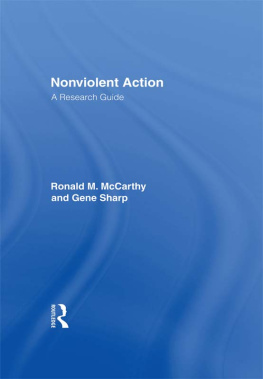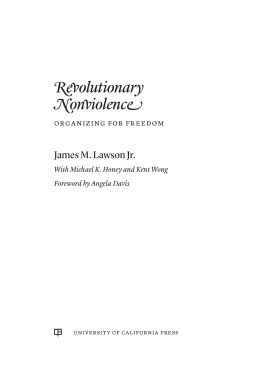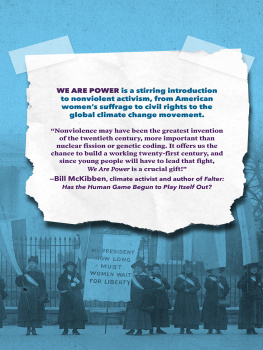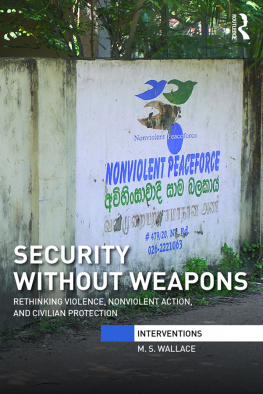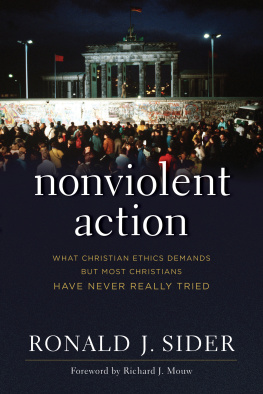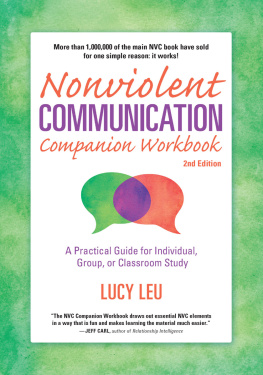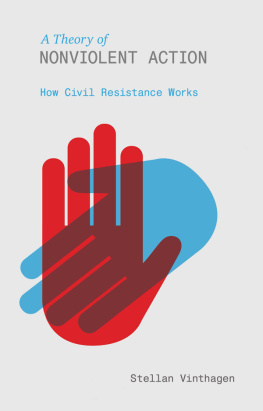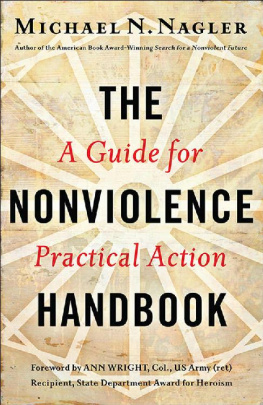NONVIOLENT ACTION
GARLAND REFERENCE LIBRARY OF SOCIAL SCIENCE
VOLUME 940
A Book
From the
Albert Einstein Institution
NONVIOLENT ACTION
A RESEARCH GUIDE
RONALD M. MCCARTHY
GENE SHARP
WITH THE ASSISTANCE
OF BRAD BENNETT
First Published by Garlandby Garland
270 Madison Ave, New York NY 10016
2 Park Square, Milton Park, Abingdon, Oxon, OX14 4RN
Transferred to Digital Printing 2010
Copyright 1997 by Ronald M. McCarthy
All rights reserved
Library of Congress Cataloging-in-Publication Data
McCarthy, Ronald M.
Nonviolent action : a research guide / by Ronald M. McCarthy and
Gene Sharp.
p. cm. (Garland reference library of social science ; v. 940)
Includes bibliographical references and indexes.
ISBN 0-8153-1577-5 (alk. paper)
1. NonviolenceBibliography. 2. NonviolenceHistoryCase studies
Bibliography. 3. Protest movementsHistoryCase studies
Bibliography. I. Sharp, Gene. II. Title. III. Series.
Z7164.P19M33 1997
[HM278]
016.3036'1dc21
97-25316
CIP
Publisher's Note
The publisher has gone to great lengths to ensure the quality of this reprint
but points out that some imperfections in the original may be apparent.
Contents
Preface and Acknowledgments
The Twentieth Century has seen the discovery of nonviolent action and its significance as a means of struggle. This is true not only of the enormous growth in its use, but also of the scholarly effort to define, delineate, and understand this important alternative to violence, and to helplessness and passivity as well, for people engaged in acute and vital conflicts.
This research guide is our attempt to bring together a wide range of information on the worldwide experience of using nonviolent action, both historical and contemporary. It is intended to be useful for researchers at many levels of expertisestudents, academics, journalists, and otherswho want to draw on this experience. This research guide also stands as a demonstration, if one is needed, that the use of nonviolent action extends far back in history and is not limited to any nation, ethnic group, religion, or governmental form.
Gene Sharp began the work on this project in the late 1950s. At the time, he believed that all the significant existing knowledge about nonviolent action could be gathered by polling friends and colleagues in this field. As his conception of the field grew, he realized that there was a wealth of unexplored knowledge to be assembled and began to collect entries for what has become this volume. Ronald McCarthy took over the task in the late 1980s and saw it through to completion.
The authors could never have completed this study without the help and encouragement of many people. We have received research assistance from Jane Casey, Robert Cucci, William B. Vogele, Carl Etnier, Jon Klavens, Mark Haugen, and Jeff Welch. Robert Burroughs reviewed the section on Australia and suggested additions. William B. Vogele read and commented on the introduction. Roger Powers put the manuscript into shape, edited it, and offered many useful suggestions. Many thanks to Stephen Coady for his help while the manuscript was edited and printed. Sharon Fischer helped in the final stages of production. We owe a debt of gratitude to the reference and circulation staffs of the Harvard University libraries, especially Widener Library, where the majority of the work was done. Research was also conducted at the Boston Public Library, the Library of Congress, and the Hamilton Library, University of Hawaii. We thank the staffs at these institutions for their help.
This research was supported by grants from the United States Institute of Peace, which recognized the importance of studying nonviolent means of conflict at its inception. Research and writing were conducted primarily at the Program on Nonviolent Sanctions in the Center for International Affairs, Harvard University. The Albert Einstein Institution, established to advance the study and use of strategic nonviolent action in conflicts throughout the world, has been unstinting in its support of this project. Our sincere thanks to the institution's staff, executive director, and board for their faith in this project over the years.
Introduction
The Possibilities of Research
on Nonviolent Action
Dr. Martin Luther King, Jr., was in the Birmingham, Alabama city jail in April 1963. He had been arrested for leading an illegal protest march in the city's streets as part of a campaign against racial segregation. He refused to pay bail and was waiting for his trial. After a few days in his cell, he read an article in the newspaper about a statement by an interfaith group of white clergymen who criticized Dr. King and his movement, especially the unwise and untimely demonstrations it held. Although technically peaceful, they wrote, these protests led to hatred and violence. They counseled that it would be better to abandon such protests, obey the law, and take any problems to court or settle them through negotiation (Branch 1988: ch. 1820, pp. 73738).
Co-workers recall that Dr. King began at once to draft his reply, which has become renowned as Letter from Birmingham City Jail (King, 1963 in Washington, ed. 1986: 298302; Branch 1988: 73844). Dr. King uses the occasion to issue a ringing justification of protest. He first tells his reasons for coming to Birmingham, both the specific reason that he was invited by local activists and a more general one: I am in Birmingham because injustice is here.
In the following pages, Dr. King not only explains himself but he also challenges the clergymen to see that their views are not valid. He argues that the city's segregation laws are not only unjust but unjust for many reasons. Therefore, protesters have many reasons for opposing them. He challenges the complacency of white moderates who counsel the movement to avoid causing tensions that might lead to a violent response. He especially criticizes white church leaders who stand back when their help is needed and keep silent when the segregationists raise their voices.
But there is more than this in Letter from Birmingham City Jail. Dr. King also explains the rationale for his strategy for challenging segregation. Separating this from the parts just on Birmingham and from Dr. King's dialogue with the white clergy, we find two kinds of statements. First, Dr. King describes how to prepare the ground for what he calls a nonviolent campaign. Second, he describes the processes the campaign will set in motion that will encourage resolution of the grievances. Preparation has four steps, Dr. King writes, beginning with researching the facts that demonstrate that injustices exist, which is followed by negotiation with the adversary. The third step is self-purification, which means personal preparation for the hardships to come and for maintaining group discipline. After these, and only if negotiation and other available avenues have failed, can nonviolent action begin.
Dr. King also explains how this action is expected to work. He shows that nonviolent action brings tensions and contradictions to the surface that already exist but are denied and covered up. The community then may see the need to resolve these tensions. Through creative tension or constructive nonviolent tension, he argues, direct action creates such a crisis that people will want resolution, and negotiations will be held. Without this kind of pressure, people who benefit from existing conditions are unlikely to give in. Some of them will resort to violence against protesters to stop the campaign. These people must come to see that continued nonviolent pressure makes their own resistance toward change impossible to sustain.

